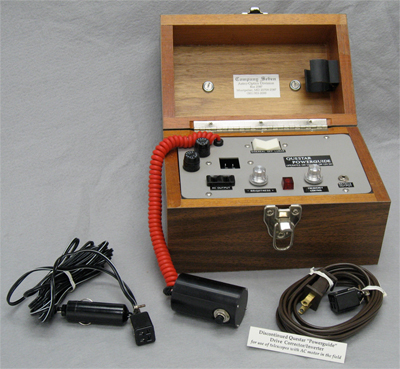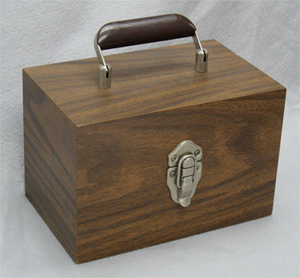Questar Distribution
![]() News
News ![]() Notes & Interesting Articles
Notes & Interesting Articles ![]() Overview
Overview ![]() Pricing
Pricing ![]() Products
Products ![]() Service or Repair
Service or Repair
Questar Telescopes ![]() LD Surveillance Systems
LD Surveillance Systems ![]() LD Microscopes
LD Microscopes ![]() Accessories
Accessories


QUESTAR POWERGUIDE AC-DC DRIVE CORRECTOR
This accessory made for the Questar 3-1/2 and for the Questar 7 Fork mounts. It was discontinued in the mid 1980's being replaced by the Powerguide and later Powerguide II drive systems. The name Powerguide was also used by Questar to designate their first generation of 9 volt DC powered compact Drive Correctors which in the late 1980's replaced the original AC/DC powered model described in this article, this unfortunately has caused some confusion.
This article is provided as a courtesy by Company Seven for those customers who have helped to keep us in business.
 Preface: Company Seven is a resource for the international astronomical, nature watching and law enforcement/defense communities. We are the only Questar agent for their Consumer, and Industrial (Surveillance and Long Distance Microscope and Remote Measurement Systems) product lines. We are proud to present Questars for research, education and recreation to government, industry, and the most demanding amateur. The National Aeronautics & Space Administration (to whom we supplied Schmidt-Camera telescopes for the International Halley Watch), the U.S. Naval Observatory, the Smithsonian Institution, and the more demanding amateur astronomer and naturalist are our most prominent references.
Preface: Company Seven is a resource for the international astronomical, nature watching and law enforcement/defense communities. We are the only Questar agent for their Consumer, and Industrial (Surveillance and Long Distance Microscope and Remote Measurement Systems) product lines. We are proud to present Questars for research, education and recreation to government, industry, and the most demanding amateur. The National Aeronautics & Space Administration (to whom we supplied Schmidt-Camera telescopes for the International Halley Watch), the U.S. Naval Observatory, the Smithsonian Institution, and the more demanding amateur astronomer and naturalist are our most prominent references.
Right: Questar Powerguide Drive Corrector for the Standard, Duplex, and Questar Seven telescope Fork Mounts (284,648 bytes).
The Powerguide is shown at right with the lid opened to reveal the hand held push button control stored on a clamp in the lid. The white rocker switch selects either off, or sets the motor frequency to track at either Sidereal (deep sky) or Lunar rates. There are dial controls to adjust motor frequency (speed), and the Reticle Output voltage to set brightness level for the optional Illunated Reticle Guiding Eyepiece. There is a four pin receptacle for either AC current input or 12 volt DC input, and a two prong socket for AC power output to the Questar Fork Mount via the AC power cord provided with AC powered Questar telescopes. A red light (between Brightness and Frequency dials) indicates when power is "on".
The unit shown here was donated by our customer to Company Seven's museum collection and is displayed in our showroom. Note the original "Company Seven" label in the lid which helps date this to the 1980-1984 period.
Click image to see enlarged view (500,693 bytes).
Introduction: The Questar 3-1/2 telescopes have been in production since 1954 with some changes over the decades, while the first Questar Seven S/N Serial No. P-7-1 was introduced in the Spring of 1967. As the Earth rotates along its axis objects in the sky appear to move in an arc rising on one horizon, climbing into the sky then descending and setting on the opposite horizon. Motorized Fork and German style equatorial mounts were developed so that telescopes could track celestial objects, compensating for the Earth's rotation by moving the telescope optical tube assembly in the exact opposite direction and same apparent speed as the Earth rotates and this keeps objects in the field of view providing convenience. By the 1960's with the advancement of film technologies astrophotography was becoming more and more possible by the amateur and new specialized accessories (Off Axis Guider, etc.).
The Standard and Duplex telescope models are furnished with a motorized fork style drive base. While buyers of their larger cousin the Questar Seven are provided with the choice of the Questar Seven Fork Base or third party German Equatorial mounts. Each Questar fork is provided with a set of three lightweight alloy legs to form a tripod that is adjustable for latitude. Two of the legs are made to thread into the drive base at two points on the side, and a Pole Axis leg threaded into the bottom of the cast aluminum base. This tripod arrangement permits Pole Alignment of the mount by extending the Pole Axis leg, and the mount with the telescope may be operated on a table top. The Fork is provided with a manual control knob for turning the telescope left to right on the Fork Base, this is referred to as Right Ascension since in the Northern Hemisphere the motion appears to follow rising objects in a clockwise and ascending motion. The Fork also incorporates a manually geared control for elevation, referred to as Declination since this controls how high in the North or down into the Southern hemispheres the telescope is pointed.
 "Instructions for Questar Powerguide" Moderate resolution scanned copy of original Questar complete three page typed instructions for the version of the Powerguide AC-DC powered Drive Corrector as was provided up to about 1985. The copy shows fold marks and its age resulting from how it was stored in a Powerguide lid. Scanned copy of original from Company Seven's Archives. Download size is 230,133 bytes (in Acrobat Reader ".pdf" format).
"Instructions for Questar Powerguide" Moderate resolution scanned copy of original Questar complete three page typed instructions for the version of the Powerguide AC-DC powered Drive Corrector as was provided up to about 1985. The copy shows fold marks and its age resulting from how it was stored in a Powerguide lid. Scanned copy of original from Company Seven's Archives. Download size is 230,133 bytes (in Acrobat Reader ".pdf" format).

Right: Questar Powerguide with both provided power input cables: one for AC (brown) and the other for 12 volt DC cord (black) to connect via a cigarette lighter plug (135,865 bytes).
Click image to see enlarged view (404,171 bytes).
The Fork Base is initially furnished with a choice of either a 120 or 220 volt AC motor with a detachable power cord. When plugged into AC power the synchronous motor turns the telescope at a rate of about one revolution per twenty four hours allowing the telescope to track objects across the sky. When ordering the Questar Fork and Base drive system the customer would either specify their preference for North or South Hemisphere. The drive system also moves the Right Ascension Setting Circle making it and the provided fixed Declination Setting Circle useful aids for navigating the night sky.
 The manual geared controls provided on all Questar Fork mounts are useful for making adjustments of the telescope up or down, and left or right to center it onto one target or another. However, for astrophotographic applications or in some other instances it becomes necessary to be able to make very fine adjustments - so fine as to be visually imperceptible unless one is looking through the telescope.
The manual geared controls provided on all Questar Fork mounts are useful for making adjustments of the telescope up or down, and left or right to center it onto one target or another. However, for astrophotographic applications or in some other instances it becomes necessary to be able to make very fine adjustments - so fine as to be visually imperceptible unless one is looking through the telescope.
The Varitrac: To make it possible to travel with the Questar telescope and to operate the AC powered Drive of the telescope from a 12 volt DC battery, and to obtain fine control of the Right Ascension axis Questar developed their first Drive Corrector, the "VARITRAC". The Questar Varitrac is a 12 volt DC powered Drive Corrector that permits the user to vary the AC motor speed from between 56 cycles up to 64 cycles per second. The hand held control box incorporates a rotary dial so that the operator can select the exact tracking rate of the AC motor to operate at a sidereal rate, or adjust the drive to the lunar tracking rate thereby nullifying its rapid retrograde drift when operating on sidereal time. The hand held controller also incorporates two push momentary buttons, one for faster and the other to slow the speed of the telescope drive. Varitrac was developed and offered for sale by the Summer of 1964; the price of this accessory then was a hefty $129.50 at a time when the complete new Questar 3-1/2 Standard Telescope sold for $995.00 ($1,095 with Quartz mirror).
The Powerguide: Replacing the Varitrac was the original "POWERGUIDE". The Powerguide is among those devices that were developed which provides the Questar 3-1/2 fork mount user with the capability to operate the telescope in the field off 12 volt DC power sources, and also to make fine adjustments to facilitate the precise tracking of celestial objects. The Powerguide differs from the Varitrac in that the Poweguide adds the capability also operate from AC current.
This original Powerguide and Varitrac made no provision for fine control of the Declination (elevation). And so to make fine adjustments in Declination possible Questar devised the Questar 3-1/2 Declination Vernier Manual Drive a precisely made gear reduction device. For owners of it's larger cousin, the Questar 7 Declination Vernier Manual Drive was made available.
The Powerguide unit shown in this article was originally sold by Company Seven to a customer who later upgraded to the 9 Volt DC Powerguide system. To give some idea of the price of the unit it sold in 1975 for $127.50 when the typical Questar Standard 3-1/2 telescope sold for $1,315.00 - yes this was a long time ago.
To operate an Illuminated Reticle eyepiece, plug the illuminator power cord into the Reticle Output receptacle on the panel. Adjust the brightness up or down by turning the dial as needed.
Each power input is protected by quick blow fuse. If the unit ceases to operate, first check the fuse protection. Push and twist the black circular cover counterclockwise to remove the fuse.
With the introduction of the DC powered Powerguide I the original AC Powerguide was rendered obsolete.
In order to obtain precise control of the Questar Fork Mount Declination Axis the Questar 3-1/2 Declination Vernier Manual Drive and Questar Seven Declination Vernier Manual Drive were developed, and these too were discontinued in favor of motorized versions when the original Powerguide was discontinued.
| Power Requirements | AC* or 12 Volt DC |
| AC Input Fuse Rating | ACG 2 Amp 250V |
| DC Input Fuse Rating | ACG 2 Amp 250V |
| Case Dimensions | 8-3/4 W x 6-3/4 H x 5-3/4 D |
| Weight (complete set) | 6 lb. 7.0 oz. / 2 kg. 918 Gr. |
* Provided in customers choice of either 110 volt AC or 220 volt AC.
ADDITIONAL READING:
We invite you to visit our showroom near Washington, D.C. to see a Questar first hand. Or contact us by E-mail to info@company7.com, or by telephone at 301-953-2000. The showroom is open Monday to Friday 11 am to 6 pm, Saturday 11 am to 5 pm. We are closed on Sundays, on U.S. Holidays, and from 25 December through 1 January inclusive.
Contents Copyright 1994-2024 Company Seven All Rights Reserved

